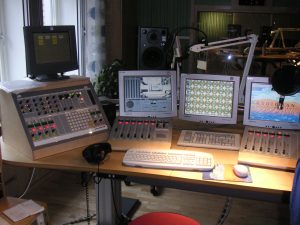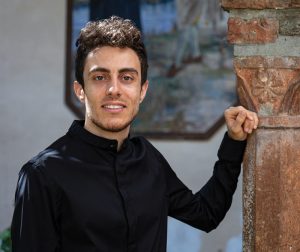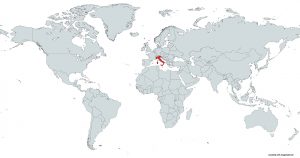Giovanni Cestino, Musicologist, Italy
As with most of our daily activities, not even the act of making music (in this case, choral) can avoid the constant interaction with technology and which, in many cases, may even surrender to the resources offered by the internet.
Think back to your last concert for a moment (please forgive the author for reminding you of this, given the current situation): how much of your sheet music came from the Internet, rather than from a library? How often have you listened to a performance somewhere online and how often have you practised exclusively on the piano or in a choir instead? How often have you bought a copy by ordering it from the comfort of your desk, rather than in person at your trusted music store? You will get hardly any answers that do not include at least some type and level of technological intervention, and there is nothing wrong with that. However, observing everything go digital in our choral experience can inspire us to proceed with greater awareness in the future, particularly during this time of overexposure to the virtual world in which we are all living.
The same is said in all languages: the Internet is an encyclopaedia (to use a term dear to the author and philosopher Umberto Eco) which is not always reliable since it is the result of an unstoppable plethora of operations – independent or collaborative, but not always verified – and, all things considered, accessible to us easily and in great quantity. From this point of view, choral music certainly enjoys a privileged place if we consider that, among the virtual archives of musical texts – the most famous of which being the International Music Score Library Project (IMSLP) – the world of choral music is the only one to benefit from a site entirely dedicated to its own repertoire, namely the Choral Public Domain Library (CPDL).
As for the entries on Wikipedia, the quality of its nearly 35,000 pieces of sheet music, provided by users from all over the world, varies greatly in terms of reliability and accuracy: they range from a kind of do-it-yourself philology – that is, put together using sources readily available to the editor, and usually with poor methodological rigour – to a sort of illogical transcription of mensural notation with a few too many flats in the key… This same variation in quality can also be found in the information that accompanies the works (for those who want a taste of this, I refer you to the page “Matona, mia cara” by Orlando di Lasso).
However, community-driven projects (i.e., those which allow all users to contribute freely) should not be stigmatised as such, especially when there appear to be some lucky exceptions: I am thinking, for example, of GregoBase, a database of Gregorian scores; created on an entirely voluntary basis, but which stands out for its richness, precision and – most importantly – for how verifiable the information on the site is.
It is a different matter, however, for the commendable activity of releasing scientific publications online. Alongside some more traditional ones such as the well-known Neue Mozart-Ausgabe (NMA) or The New Guillaume Du Fay Opera Omnia – sadly left unfinished by the late Alejandro Enrique Planchart – there are other more innovative ones, such as the Marenzio Online Digital Edition (MODE) or the Gaffurius Codices Online (GCO), which harness the full potential of digital hypertext to become remarkably versatile tools for study and research.

We are therefore unable to ignore the huge benefits of the Internet for ‘exploration’ in our day-to-day relationship with written music, which are just as valid for any digital archive as they are for the many bibliographic tools at our disposal. In fact, nowadays any search for a musical text should, without exception, pass either via online public access catalogues – for example, OPACs of individual libraries, national OPACs or META-OPACs such as WorldCat – or via inventories, such as the RISM (International Inventory of Musical Sources). In all cases, only one commandment applies: never stop after just one click. Investigate further, be curious, and above all, question what you find. Place the same value on selecting which edition to base your performance on as you would when making any other interpretative decision.
In the transition from text to performance – or rather, in the continued relationship between these two pillars of making music – the potential for digital technologies is becoming more and more significant, again both in open forms and for proprietary products. Alongside platforms such as Choralia with its wide selection of MIDI files for studying music, you can also find publishing initiatives, such as those by Carus-Verlag whose app lets you study the different scores in their catalogue on your mobile device. You can highlight your part in a professional recording (and then sing over it), reduce the speed to practise more complex passages, or easily jump from one point to another in the score with a single tap on the screen. Apps such as this are significantly reshaping how technology contributes to learning music and are even changing the mission of music publishers: they no longer simply print pages of music, but instead want to offer innovative tools for studying them too.
From sheet music to performance, digital technologies have gradually found their place in performing too. Though the glow from Yuja Wang’s iPad is no longer making headlines, it is no less true that more and more publishers are succumbing to the lure of digital distribution, to the extent that alongside app or e-book stores, there are now also sheet music stores (if you have never heard of them, try typing “nkoda” into your search engine). Here too, transitioning from paper to screen is always done in the name of ‘gaining experience’: what was previously done in analogue form must also be possible digitally. It is for this reason that all apps (from Bärenreiter’s or Henle’s, to free ones like Piascore) allow you to add annotations, change the page layout, and so on.
In comparison with other musical contexts, however, the choral world still seems attached to traditional dynamics: paper continues to be the undisputed master of the stage, perhaps on account of the healthy nature of equality that making music in a choir should inspire. Can thirty people all be expected to own a good tablet (let alone a dazzling e-ink tablet such as the PadMu), even if this would solve problems of lighting, individuals leafing through their parts in the middle of a concert, or losing copies and not being able to recover them from somewhere on the cloud?
The digital world and making music, therefore, seem to be conducting a long and elegant dance of seduction, but most importantly one that is not afraid to move at its own pace. There does not appear to be any revolution in motion or even in sight, nor do we need to worry about remaining prisoners to our old analogue routines while the rest of the world slowly… goes digital. Technological lock-in (i.e., having to settle for technological conditions which are not necessarily the best but the most popular) should not be a fear, and certainly not an impediment. After all, haven’t we been satisfied for centuries – despite excellent results – with a form of collaborative technology such as our written musical compositions, even though this technique may be simplistic and imprecise?
First printed in Choraliter 61, May 2020 (https://www.feniarco.it/it/editoria/choraliter)
Translated from Italian by Luke Martin, UK
 GIOVANNI CESTINO (1992) holds a degree in Classical Guitar from the Conservatory of Alessandria, a MA in Musicology from University of Pavia, and a PhD in Musicology from University of Milan. He also took courses in Composition, Conducting, and Renaissance Lute. He collaborates with LEAV – Ethnomusicology and Visual Anthropology Lab (University of Milan), and with Centro Studi Luciano Berio (Florence). He is a faculty member at Milan Choral Academy, and has been a visiting fellow at the Harvard University Department of Music. Since 2014 he conducts the Coro Facoltà di Musicologia (Cremona). He is currently a postdoctoral fellow at the University of Milan.
GIOVANNI CESTINO (1992) holds a degree in Classical Guitar from the Conservatory of Alessandria, a MA in Musicology from University of Pavia, and a PhD in Musicology from University of Milan. He also took courses in Composition, Conducting, and Renaissance Lute. He collaborates with LEAV – Ethnomusicology and Visual Anthropology Lab (University of Milan), and with Centro Studi Luciano Berio (Florence). He is a faculty member at Milan Choral Academy, and has been a visiting fellow at the Harvard University Department of Music. Since 2014 he conducts the Coro Facoltà di Musicologia (Cremona). He is currently a postdoctoral fellow at the University of Milan.


